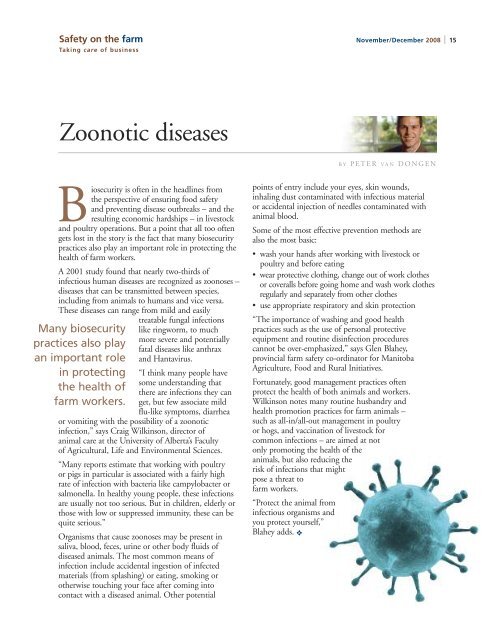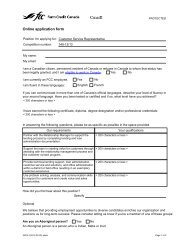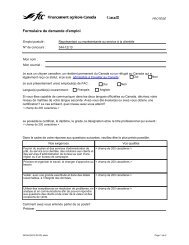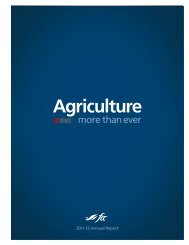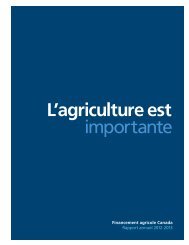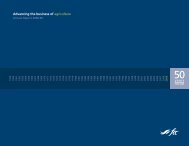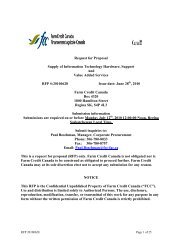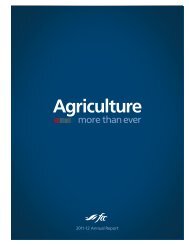Read the full version (PDF) - FCC-FAC
Read the full version (PDF) - FCC-FAC
Read the full version (PDF) - FCC-FAC
Create successful ePaper yourself
Turn your PDF publications into a flip-book with our unique Google optimized e-Paper software.
Safety on <strong>the</strong> farm<br />
Taking care of business<br />
Zoonotic diseases<br />
Biosecurity is often in <strong>the</strong> headlines from<br />
<strong>the</strong> perspective of ensuring food safety<br />
and preventing disease outbreaks – and <strong>the</strong><br />
resulting economic hardships – in livestock<br />
and poultry operations. But a point that all too often<br />
gets lost in <strong>the</strong> story is <strong>the</strong> fact that many biosecurity<br />
practices also play an important role in protecting <strong>the</strong><br />
health of farm workers.<br />
A 2001 study found that nearly two-thirds of<br />
infectious human diseases are recognized as zoonoses –<br />
diseases that can be transmitted between species,<br />
including from animals to humans and vice versa.<br />
These diseases can range from mild and easily<br />
Many biosecurity<br />
practices also play<br />
an important role<br />
in protecting<br />
<strong>the</strong> health of<br />
farm workers.<br />
treatable fungal infections<br />
like ringworm, to much<br />
more severe and potentially<br />
fatal diseases like anthrax<br />
and Hantavirus.<br />
“I think many people have<br />
some understanding that<br />
<strong>the</strong>re are infections <strong>the</strong>y can<br />
get, but few associate mild<br />
flu-like symptoms, diarrhea<br />
or vomiting with <strong>the</strong> possibility of a zoonotic<br />
infection,” says Craig Wilkinson, director of<br />
animal care at <strong>the</strong> University of Alberta’s Faculty<br />
of Agricultural, Life and Environmental Sciences.<br />
“Many reports estimate that working with poultry<br />
or pigs in particular is associated with a fairly high<br />
rate of infection with bacteria like campylobacter or<br />
salmonella. In healthy young people, <strong>the</strong>se infections<br />
are usually not too serious. But in children, elderly or<br />
those with low or suppressed immunity, <strong>the</strong>se can be<br />
quite serious.”<br />
Organisms that cause zoonoses may be present in<br />
saliva, blood, feces, urine or o<strong>the</strong>r body fluids of<br />
diseased animals. The most common means of<br />
infection include accidental ingestion of infected<br />
materials (from splashing) or eating, smoking or<br />
o<strong>the</strong>rwise touching your face after coming into<br />
contact with a diseased animal. O<strong>the</strong>r potential<br />
November/December 2008 | 15<br />
B Y P E T E R VA N D O N G E N<br />
points of entry include your eyes, skin wounds,<br />
inhaling dust contaminated with infectious material<br />
or accidental injection of needles contaminated with<br />
animal blood.<br />
Some of <strong>the</strong> most effective prevention methods are<br />
also <strong>the</strong> most basic:<br />
• wash your hands after working with livestock or<br />
poultry and before eating<br />
• wear protective clothing, change out of work clo<strong>the</strong>s<br />
or coveralls before going home and wash work clo<strong>the</strong>s<br />
regularly and separately from o<strong>the</strong>r clo<strong>the</strong>s<br />
• use appropriate respiratory and skin protection<br />
“The importance of washing and good health<br />
practices such as <strong>the</strong> use of personal protective<br />
equipment and routine disinfection procedures<br />
cannot be over-emphasized,” says Glen Blahey,<br />
provincial farm safety co-ordinator for Manitoba<br />
Agriculture, Food and Rural Initiatives.<br />
Fortunately, good management practices often<br />
protect <strong>the</strong> health of both animals and workers.<br />
Wilkinson notes many routine husbandry and<br />
health promotion practices for farm animals –<br />
such as all-in/all-out management in poultry<br />
or hogs, and vaccination of livestock for<br />
common infections – are aimed at not<br />
only promoting <strong>the</strong> health of <strong>the</strong><br />
animals, but also reducing <strong>the</strong><br />
risk of infections that might<br />
pose a threat to<br />
farm workers.<br />
“Protect <strong>the</strong> animal from<br />
infectious organisms and<br />
you protect yourself,”<br />
Blahey adds. ❖


